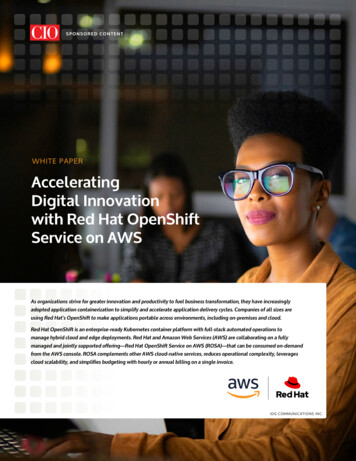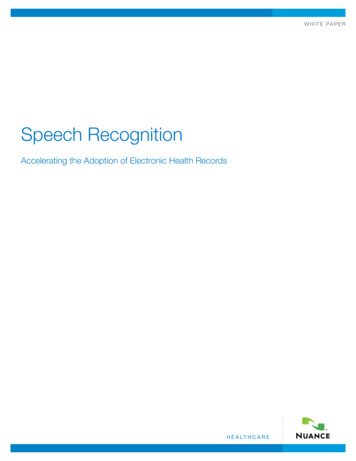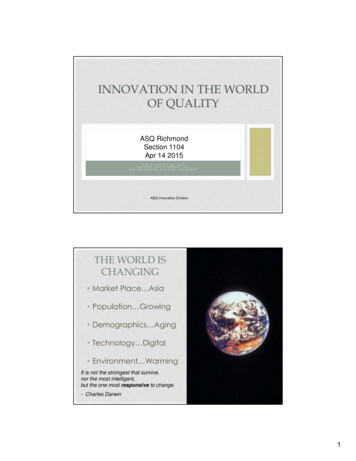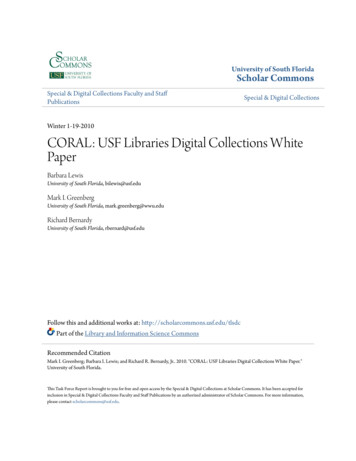
Transcription
SPONSORED CONTENTWHITE PAPERAcceleratingDigital Innovationwith Red Hat OpenShiftService on AWSAs organizations strive for greater innovation and productivity to fuel business transformation, they have increasinglyadopted application containerization to simplify and accelerate application delivery cycles. Companies of all sizes areusing Red Hat’s OpenShift to make applications portable across environments, including on-premises and cloud.Red Hat OpenShift is an enterprise-ready Kubernetes container platform with full-stack automated operations tomanage hybrid cloud and edge deployments. Red Hat and Amazon Web Services (AWS) are collaborating on a fullymanaged and jointly supported offering—Red Hat OpenShift Service on AWS (ROSA)—that can be consumed on-demandfrom the AWS console. ROSA complements other AWS cloud-native services, reduces operational complexity, leveragescloud scalability, and simplifies budgeting with hourly or annual billing on a single invoice.IDG COMMUNICATIONS INC.
2Accelerating Digital Innovation with Red Hat OpenShift Service on AWSOptimizing digital innovationOrganizations are adopting containerized applications and Kubernetes orchestrationto build, deploy, and operate applications faster and with higher security. Red HatOpenShift includes components of the Kubernetes container management projectbut adds productivity and security features out of the box that are important to largescale companies.Red Hat OpenShift was designed for an open hybrid cloud strategy, providingflexibility to run applications across diverse environments (on-premises, cloud, oredge) across a variety of options including bare metal servers and virtual machines—without having to rebuild those applications, retrain people, or maintain disparateenvironments. It can aid in the adoption of a devops culture by automating routineoperational tasks and standardizing environments across an application’s life cycle.Containerization speeds up development and deployment of cloud-native applications.Red Hat OpenShift’s full-stack automated operations, consistent experience—acrossall environments—and self-service provisioning for developers lets teams worktogether to move ideas more efficiently from development to production.Solving a new set of challengesHowever, containers introduce a new set of issues for IT to master, includingmanaging storage, failover, workload scaling and scheduling, and monitoring acrossmicroservices. Kubernetes orchestrations solve some of those issues, but deploymentcan be complicated. Even with a container orchestration and automation platform, ITcomplexity can make it difficult for some organizations to effectively build, launch, andmanage container-based applications consistently across hybrid environments.“Managing Kubernetes is hard, and many organizations are starting to realize they canbetter focus on other, as-yet unsolved engineering problems if they hand off a big chunk oftheir container orchestration responsibilities to managed service providers,” writes ScottCarey for InfoWorld.While many organizations are successful in running Red Hat OpenShift on a self-managed basis, this approach requires investing in specialized skill sets and incursadministrative overhead. Many organizations would prefer to use these resources tobuild and deploy value-add applications versus learning how to manage and maintainthe container platform.As new cloud services become available via the AWS Console, ROSA makes it simpler toprocure, provision, and manage containerized applications on AWS. IT teams can leavethe day 1 and day 2 maintenance and administration of Red Hat OpenShift to the Red Hatexperts, and instead focus all their efforts on innovative application development.IT teams can leavethe day 1 and day 2maintenance andadministration ofRed Hat OpenShift tothe Red Hat experts,and instead focusall their efforts oninnovative applicationdevelopment.
3Accelerating Digital Innovation with Red Hat OpenShift Service on AWSManaged cloud services easeself-managed resource constraintsOrganizations of all sizes and types have migrated to cloud to take advantage of managedservices that allow them to shift precious resources to business-critical tasks. Many wantto reduce the effort required to run their third-party solutions in cloud environments.Self-managing requires expertise in each environment—as well as related tools—onwhich applications will run. Even when that expertise is available, finding the resources toinstall, configure, maintain, and manage that infrastructure can be difficult and frustrating.Cloud services provide an easier, flexible consumption model for key development anddeployment platforms. As a fully managed cloud service, ROSA reduces undifferentiatedheavy lifting for Red Hat OpenShift clusters. That allows organizations to free upresources that can be better utilized for innovation and competitive purposes. Just asthey turned to cloud to avoid constantly maintaining and upgrading infrastructure, manycan benefit by leaving cloud platform management to service provider experts dedicatedto the task, and instead consume platform services on a pay-as-you-go basis.With ROSA, organizations lose the headache of “owning” the platform and allresponsibility for configuration, maintenance, and updates. ROSA allows customers topay only for what they actually consume as they scale up or down.Although ROSA is new as a service, it provides the same production-ready Red HatOpenShift that many enterprises already use on-premises today. Because ROSA is afully managed service, customers can easily deploy fully operational and fully managedRed Hat OpenShift clusters faster, while leveraging the full breadth and depth of AWS,particularly scalability and security. Large service providers such as Infosys have adoptedROSA as a preferred Kubernetes platform to build their modernization offerings.Red Hat site reliability engineering teams manage the platform, proactively solveproblems, and automate operations tasks to provide optimal performance and 99.95%uptime. Internal teams no longer must take care of tasks such as system monitoring,upgrades, patch management, backup, and problem resolution. And developers cantake advantage of familiar application programming interfaces (APIs) and existing RedHat OpenShift tools for deployment in AWS.ROSA was designed to accommodate most common use cases. However, someorganizations with highly unique use cases, specific requirements, or those that needa high level of customization may prefer to continue or start using self-managed RedHat OpenShift Container Platform. Enterprises have the flexibility to choose the bestapproach—managed or self-managed—to fit their needs.With ROSA,organizations lose theheadache of “owning”the platform andall responsibilityfor configuration,maintenance, andupdates. ROSA allowscustomers to pay onlyfor what they actuallyconsume as they scaleup or down.
4Accelerating Digital Innovation with Red Hat OpenShift Service on AWSGreater flexibility for high performanceCombining Red Hat OpenShift and the AWS Cloud as a cloud services solution speedsadoption of a flexible, high-performance application environment that supports modern,digital operations.Red Hat and AWS have collaborated since 2008, making it easy to run Red Hat EnterpriseLinux on AWS. In subsequent years organizations have been able to run Red HatOpenShift Container Platform and Red Hat OpenShift Dedicated on AWS. ROSA extendsthe collaboration with a fully managed, self-service experience for cluster creation andoperations, deeper integrations with AWS services, on-demand (hourly) billing, a singleinvoice through AWS, and the ability to contact Red Hat or AWS for support.In the past, organizations deploying application workloads within Red Hat OpenShift onAWS had to deal with two providers and two separate bills. This could result in the cus-tomer going back and forth between Red Hat and AWS specialists to gain understandingof the underlying components of their OpenShift on AWS implementation, including thenumber and sizing of EC2 instances, and how those relate to application workloads.With Red Hat specialists handling the Red Hat OpenShift platform management in thebackground, development and operations teams can commit their time and efforts to buildingand deploying containerized applications that provide the most value to their business.ROSA subscriptions can be purchased directly from within the AWS Management Console.The process is very simple: Enable ROSA in the AWS account with a single button click,which subscribes the AWS account to the ROSA subscription. Customers can get up andrunning within minutes with self-service deployment using a simple API and command lineinterface to create fully managed Red Hat OpenShift clusters.In the AWS Management Console, users can find Red Hat OpenShift Service on AWS asan additional container services option along with Amazon Elastic Kubernetes service andAmazon Elastic Container Service. On the ROSA landing page, clicking on the ‘enableOpenShift’ button enables the use of ROSA within the user’s AWS account. From then on,any use of Red Hat OpenShift Service on AWS within that account will automatically billfor any OpenShift subscriptions, and users will be able to view the cost for the underlyingAWS resources such as EC2 instances.AWS License Manager can be used to create rules that span various AWS accounts withinan organization. Once the ROSA service is enabled in a main payer account, it can then beenabled across the entire organization. This allows teams in non-payer accounts to enablethe ROSA service even if they are not able to sign up for AWS marketplace solutions. Aflexible pay-as-you-go pricing model offers a choice of an on-demand hourly or annualbilling model for discounted costs.These subscription and provisioning processes provide ready access to a wide range ofrobust AWS services such as compute, database, analytics, machine learning, networking,mobile, and other services that complement application workloads that are running asRed Hat OpenShift containers.Development and operations teams can take advantage of on-demand availability,elasticity, and agility, to run modern and existing applications that the business wantsto get up and running quickly, using a familiar management interface. Organizations canSubscription andprovisioning processesprovide ready accessto a wide range ofrobust AWS servicessuch as compute,database, analytics,machine learning,networking, mobile,and other servicesthat complementapplication workloadsthat are running asRed Hat OpenShiftcontainers.
5Accelerating Digital Innovation with Red Hat OpenShift Service on AWSutilize familiar Red Hat OpenShift APIs and existing tools, with integration to AWS APIsto support cluster creation and access to other native AWS services.In the event of issues or questions, organizations can contact support from either Red Hator AWS to begin troubleshooting or get answers. Red Hat and AWS support members willjointly triage any problems to determine the cause and appropriate resolution.Frictionless implementationEase of use and scalability are the hallmarks of ROSA. An administrative user can addand remove users and projects, manage project quotas, view cluster usage statistics,and change the default project template. Admins can also scale a cluster up or down ordelete an existing cluster.Red Hat OpenShift clusters are visible within the Red Hat OpenShift Cluster managervia console.redhat.com. This shows all Red Hat OpenShift clusters, including self-managed OpenShift Container Platform clusters running on-premises or on AWS, andfully managed ROSA clusters running on AWS.When logging in to a cluster via either the command line interface or the AWSManagement console, users find a consistent experience with any other flavor ofRed Hat OpenShift. Developers can create projects, deploy applications, and makeuse of templates or operators via the operator hub. Clusters can be configured to beautomatically upgraded during a customer-defined maintenance window to the latestrelease, or users can select to manually upgrade on their own schedule—although if acluster falls too far behind the latest release it will be subject to automatic upgrading.Organizations can deploy clusters across multiple Availability Zones in supportedregions to maximize availability. Auto-scaling and auto-healing of worker or computenodes has been available for some time now via machine sets. ROSA supports machinepools, which expands the concept of a machine set to multi-Availability Zones so userscan define a single machine pool that spans more than one Availability Zone.For simplicity’s sakeFor most organizations, Red Hat OpenShift is the means to an end: more efficientlymanaging, running, and scaling their applications, versus expending resourceson administrative aspects of achieving that state. ROSA makes it even easier fororganizations to focus on deploying applications and accelerating innovation by movingcluster life cycle management to Red Hat and AWS. With many organizations alreadyRed Hat OpenShiftclusters are visiblewithin the Red HatOpenShift Clustermanager viaconsole.redhat.com.This shows all Red HatOpenShift clusters,including selfmanaged OpenShiftContainer Platformclusters running onpremises or on AWS,and fully managedROSA clusters runningon AWS.running Red Hat OpenShift on-premises, ROSA simplifies the process of shiftingworkloads to the AWS public cloud as business needs change. With ROSA, Infosys wasable to migrate their Infosys Cloud Native Development Platform, originally developedon top of Red Hat Openshift, to AWS with the same tooling and skill set.Infosys Cloud Native Development Platform supports both Red Hat OpenShift and ROSAand allows customers to develop modern applications across on-premises and cloud.Fully managed and jointly supported by Red Hat and AWS, ROSA combines the powerof Red Hat OpenShift and the AWS cloud so that development teams can focus onbetter serving their businesses and establishing a more cost-effective and reliable ITplatform for their applications.For more information,visit aws.amazon.com/rosa
6Accelerating Digital Innovation with Red Hat OpenShift Service on AWSOpenShift: The Enterprise-readyContainer Application PlatformRed Hat OpenShift has become the leading enterprise container application platform,providing organizations with greater flexibility across on-premises and cloudinfrastructure. According to one report, Red Hat accounted for almost 48% of all2020 ContainerSoftware Revenuecontainer software revenue in 2020.Red Hat OpenShift incorporates Kubernetes and adds a secure, enterprise-gradeLinux operating system, container runtime, networking, monitoring, registry, andauthentication and authorization solutions to provide a comprehensive enterpriseapplication platform.Kubernetes is an open source project that relies on community support. Red HatOpenShift is also based on OKD, an open source and community-supported distributionof Kubernetes, but a subscription comes with paid enterprise-level support for its full48%technology stack. It provides an enhanced UI and stronger security policies to meetenterprise requirements. Red Hat OpenShift includes hundreds of fixes to defect,security, and performance issues for upstream Kubernetes in every release.Red Hat OpenShift is optimized to improve developer productivity and promoteinnovation. It provides full-stack automated operations to manage hybrid cloud andedge deployments, including software-defined networking. It also validates additionalcommon networking solutions as well as numerous storage and third-party plugins forevery release.Organizations can deploy Red Hat OpenShift as a fully managed service on theirpreferred cloud provider for a seamless experience. Or they can choose a self-manageddeployment of Red Hat OpenShift Container Platform in the environment of their choice.Red Hat OpenShift delivers a complete application platform for both traditionaland cloud-native applications, allowing them to run anywhere. Through a commonabstraction layer across any infrastructure, Red Hat OpenShift provides both developersand operations teams with commonality in how applications are packaged, deployed,and managed. Organizations can run applications where it makes the most sense,without creating different operational models because of the host environment.Red Hat OpenShift provides diverse application modernization and migrationcapabilities to fit specific enterprise needs. Modernization tools can drive legacyapplications to new, microservices-based architectures. Organizations can drivemanagement consistency across all applications for operational efficiency withoutslowing innovation.According to onereport, Red Hataccounted foralmost 48% of allcontainer softwarerevenue in 2020.
7Accelerating Digital Innovation with Red Hat OpenShift Service on AWSInfosys CobaltInfosys Cobalt is a set of services,The Infosys Cloud Native Development Platform, a part of Infosys Cobalt, is aturnkey solution that addresses the technology, commercial, and support require-solutions, and platforms that acts asa force multiplier for cloud-powered ments of digital transformation initiatives. It runs on the powerful Red Hat OpenShift ;enterprise transformation. Infosysboth on-premises and on cloud managed services e.g. Red Hat OpenShift Service onCobalt helps businesses redesignAWS (ROSA) and integrates with other leading open source technologies to acceleratethe enterprise, from the core, andend-to-end application development lifecycle.also build new cloud-first capabilitiesThe Infosys Cloud Native Development Platform automates the non-functionalto create seamless experiences inbusiness logic, significantly enhancing the developer productivity. It helps theacross PaaS, SaaS, and IaaS landscapes.provisioning of environments and helps start the development of new microservicesleverage, enterprises can rapidly launchof drag-&-drop controls and a rich component repository. The inbuilt DevSecOpsto meet changing market needs whileOpenshift environment. The entire process is secure by design including RBAC, codeglobal, regional and industry regulatory aspects of cloud-native development and enables the developers to focus on thepublic, private and hybrid cloud,developers lay a solid foundation by helping select the best-fit architecture, automatesWith Infosys Cobalt’s communityand batch jobs within minutes. A developer can quickly create rich UI with the helpsolutions and create business modelspipelines and observability tools are auto-provisioned and fully integrated into thecomplying with the most stringentscanning and container security.and security standards.The architecture-first approach of the Infosys Cloud Native Development Platformgreatly simplifies the development and deployment of container-based modernapplications on industry-standard Kubernetes infrastructure, whether on-premiseor on the cloud. The platform combines the native capabilities of Kubernetes withInfosys experience, best practices and tools to accelerate cloud native development.It helps the developers start a project within minutes instead of months, reducesdevelopment effort by up to 40%, and greatly reduces the complexity of cloud nativedevelopment projects.For more information, visit aws.amazon.com/rosa 2021, Amazon Web Services, Inc. or its affiliates. All rights reserved.Learn more about Infosys Cobalt andInfosys Cloud Native DevelopmentPlatform
manage hybrid cloud and edge deployments. Red Hat and Amazon Web Services (AWS) are collaborating on a fully managed and jointly supported offering—Red Hat OpenShift Service on AWS (ROSA)—that can be consumed on-demand from the AWS console. ROSA complements other AWS cloud-native services, reduces operational complexity, leverages











